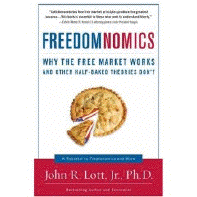
Freedomnomics
HOW can we get back to feeling safe about taking the kids to school, going about our work and meeting friends for a coffee?
Islamic terrorists have demonstrated that they can attack anywhere, without any notice.
The murder of 10 journalists at their magazine’s Wednesday morning editorial meeting in central Paris reminded us that the pre-Christmas siege of a Martin Place cafe in Sydney was not unique. Around the world, people have been attacked as they go about their daily routines. Attack apparently encouraged by the propaganda efforts of the terror group known as ISIS.
In May a shooting attack at the Brussels Jewish Museum left four dead. In September there were beheadings in Oklahoma and London. In October there was a car attack in Quebec, a shooting at Canada’s Parliament in Ottawa, an assault with a hatchet in New York City, and a knife attack in Israel that left five dead at a synagogue. There have been many others.
Perhaps in acknowledgment that gun laws already prohibited Man Haron Monis from obtaining a firearm, the Abbott Government is being encouraged to increase access to personal internet histories in the hope that this will help security agencies to identify and apprehend potential attackers.
That seems a rather forlorn hope given that Monis was already well known to police and security agencies, the courts and the media. And would-be lone attackers who have previously avoided the attention of the authorities are likely to avoid internet activities that alert law enforcement agencies.
Ottawa shooter Michael Zehaf-Bibeau’s long criminal history, including robbery, violent threats and various drug offences, meant he could not buy a gun legally, yet he still got one. Similarly, the killer in Belgium, Mehdi Nemmouche, and at least one of the killers in Wednesday’s Paris attack had violent criminal records, yet both illegally obtained machineguns — weapons that no civilians are allowed to own.
Is it time to accept that even with the best will and best resources in the world, there are limits to how well police and security agencies can protect us?
Other countries have learned some valuable lessons on terrorism. Probably the most important one is that terrorists determine the place and timing of their attacks.
For decades, Israel responded to terrorist attacks by putting more armed police and military on the streets. Mass killers either wait for officers to leave the scene or kill them first. Israel found that no matter how much money they spent, terrorists found opportunities for attacks.
Now almost 15 per cent of Israel’s adult Jewish civilian population is licensed to carry weapons. Attackers find it harder to find soft targets when they can’t be sure who is carrying a concealed handgun.
Killers seek out places where victims are sitting ducks. Elliot Rodger, who in June shot dead three people in Santa Barbara, California, explained that he avoided what would otherwise have been a better target because he feared someone with a gun would stop him before he could kill enough people.
The perpetrator of a mass shooting a couple weeks later in Moncton, Canada, Justin Bourque, poked fun at gun-free zones on his Facebook page with cartoons of defenceless victims made to look like fools.
Since at least 1950, virtually all the mass public shootings in the US and all the attacks in Europe have taken place where civilians are banned from carrying guns.
Perhaps we should consider letting police carry guns while off duty. Some will likely visit their local cafe or shopping mall while out of uniform. With more than 51,000 police officers in Australia, they won’t cover most targets, but it would still be a start, and attackers won’t know where they are.
In the US, at least one in 20 adults has a concealed handgun permit. As a consequence, permit holder Mark Vaughan stopped the Oklahoma terrorist attacker from beheading a second victim.
Hopefully, such murderous and unsettling attacks won’t continue, but in case they do, an effective back-up plan is needed.
Imagining that the Government can stop terrorists from getting weapons and that monitoring the internet will reliably provide actionable warnings is just wishful thinking. In contrast, we know that armed self-defence saves lives.
Dr Kesten Green researches forecasting for public policy and business at UniSA. Dr John Lott is the president of the Crime Prevention Research CentER and a former chief economist at the US Sentencing Commission.
John R. Lott Jr. is the president of the Crime Prevention Research Center and the author of the recently released “At the Brink: Will Obama Push Us Over the Edge?”

Article published Thursday, January 8, 2015, at The Advertiser.
Kesten Green and John Lott: There are limits to how well police and security agencies can protect us
By John R. Lott, Jr.
|
Home
Johnlott.org
(description of book, downloadable data sets, and discussions of previous controversies)
Academic papers:
Social Science Research Network
Book Reviews:
For a list of book reviews on The Bias Against Guns, click here.
---------------------------------
Posts by topic
Fraudulent website pretending to be run by me
The Merced Pitchfork Killings and Vin Suprynowicz's quote
Mother Jones article
Links
Interview with National Review Online
Lyonette Louis-Jacques's page on Firearms Regulation Worldwide
The End of Myth: An Interview with Dr. John Lott
Some data not found at www.johnlott.org:
Updated Media Analysis of Appalachian Law School Attack
Since the first news search was done additional news stories have been
added to Nexis:
There are thus now 218 unique stories, and a total of 294 stories counting
duplicates (the stories in yellow were duplicates): Excel file for
general overview and specific stories. Explicit mentions of defensive gun use
increase from 2 to 3 now.
Journal of Legal Studies paper on spoiled ballots during the 2000 Presidential Election
|